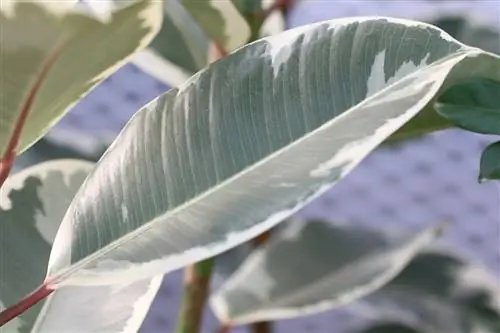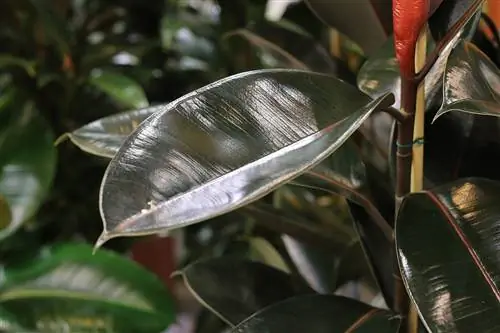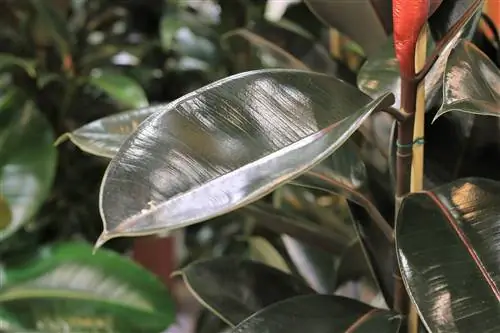- Author admin [email protected].
- Public 2023-12-17 03:39.
- Last modified 2025-01-24 12:45.
Caring for the rubber tree is not complicated. Ficus elastica, also known as Ficus robusta or Ficus tineke, is a robust and undemanding plant whose he alth depends heavily on the location.
Profile
- Plant family: Mulberry family (Moraceae)
- Genus: Figs (Ficus)
- Synonyms: Indian rubber tree
- Origin: northern East India to Indonesia
- Growth form: tree, evergreen, forms long aerial roots, semi-epiphyte
- original growth height: 2,000 cm to 6,000 cm
- Growth height when kept in a pot: 100 cm to 300 cm
- Flowers: inconspicuous, are formed in the inflorescence, 10 mm large, monoecious
- Leaves: 8 cm to 45 cm long, leathery, entire margins, top dark green, bottom light green
- Fruit: pollinated exclusively by fig wasps (Agaonidae), no fruiting possible outside the home, inedible
Location
Rubber trees in Central Europe are primarily cultivated as pot plants because it gets much too cold for them outdoors. To maintain the vitality of Ficus robusta, the right location is essential and should be as follows:
- Light requirements: bright to partially shaded
- avoid direct sun
- min. 18°C
- not too hot
- protect from drafts
Note that rubber trees require warm temperatures year-round. For this reason, you must choose a place that does not get drafts in winter, as the cool air is a problem for the ficus.

Tip:
If you want to move the fig tree outdoors over the summer, that's not a problem. Make sure that the temperatures don't fall below 15°C, otherwise it will be too cold for the rubber tree.
Substrate
Rubber trees are planted in sufficiently large pots including drainage holes. They are important to prevent waterlogging, which can cause major problems when caring for rubber trees. The pots are ideally filled with the following substrate:
- Houseplant, green plant or compost soil
- Incorporate coconut or wood fibers
- Create drainage
- Drainage material: gravel, pottery shards, perlite
Repotting
Another part of rubber tree care is repotting. Moving to fresh substrate is important for Ficus robusta when the entire pot is rooted. The following instructions will help you:
- Carefully remove the plant from the container
- Removing soil from root balls
- cut off dried, dead or rotten roots
- prepare new pot
- Don’t forget the drainage layer
- Insert plant
- fill with substrate
- moisten well
- Press the soil carefully
Pouring
It is not difficult to water the ficus. Rubber trees receive water as needed, otherwise they quickly become too wet. Waterlogging, in turn, can lead to various diseases that would severely affect the rubber tree. Therefore, always first check the substrate for dryness using a finger test. If the first layer is slightly dry, water. Since rubber trees are sensitive to limescale, you must use the following water options when watering:
- Filter water
- stale tap water
- Rainwater
Note:
If the leaves of the Ficus robusta suddenly fall off, you have to repot the plant due to waterlogging. Be sure to remove any rotten roots to allow the fig to recover.
Fertilize

Rubber trees are fertilized from spring to the end of summer. As soon as autumn arrives, fertilization is no longer carried out. Use a high-quality green plant fertilizer and administer it via irrigation water every two weeks. Never fertilize the Ficus elastica through the leaves. Otherwise burns will occur, which will have a negative impact on the he alth of the plant.
Note:
If the leaves yellow and wither within a short period of time, the fig is suffering from chlorosis. The cause is a magnesium deficiency, which you have to compensate for by adding appropriate nutrients.
Leaf Care
The rubber tree and its varieties form very large leaves. This often leads to a layer of dust forming on them. Not only is it unsightly, but it also has a negative effect on the absorption of moisture from the air. For this reason, you should clean the leaves at regular intervals. To do this, the entire plant is wiped with a damp cloth and then placed in the shower. The bucket is wrapped with foil so that no moisture gets into the soil, as the shower water could contain lime. Rinse the plant well and let it drain so that the substrate does not become too moist. To prevent another layer of dust, spray the leaves weekly with lime-free water.
Propagate
Ficus elastica is ideally propagated via cuttings. Head cuttings are a much simpler method, as cultivation from seeds cannot always be guaranteed. For head cuttings, cut off shoots on the rubber tree that are five to ten centimeters long. Then remove all leaves from the lower half, as this part is needed for rooting. There must be at least one leaf and one bud on the head cutting for propagation to be successful. The following points explain the further process:
- Wet head cuttings with willow water
- alternatively use root activators
- Prepare cultivation pots
- Use low-nutrient potting soil
- Stick cuttings into the substrate
- Half should look out of the ground
- moisten with water
- Water must be free of limescale
- cover with transparent film
- alternatively place in mini greenhouse
- choose a warm and bright place
- Check the substrate regularly and moisten if necessary
- ventilate regularly
- new shoots indicate rooting
- usually takes eight to twelve weeks
- then remove foil
- Young plant must root through the growing pot
- can take three to five months
- then repot and care as usual
Cutting
When caring for Ficus elastica, pruning is not necessary regularly. It is particularly suitable for young plants that need to grow even more extensively. If your rubber tree becomes too tall, you can easily shorten it. In order to carry out the cut as effectively as possible, the timing is important:
- End of winter
- beginning of spring
At this point, not as much milky juice is produced, which makes pruning easier. Be sure to wear gloves when cutting if you have a latex allergy. The escaping milky juice can cause an immediate allergic reaction upon contact. The milky juice even has an irritating effect on the skin of non-allergic people. You should also protect the floor with painter's foil or newspaper. The milky sap can cause discoloration on surfaces that can no longer be removed. The same applies to clothing. Don't wear your best wardrobe to the cut. The following instructions cover the most important steps:
- Disinfect and sharpen secateurs
- If the Ficus is too large, shorten the main shoots to the desired height
- always cut over one sheet
- Shorten side shoots
- always keep the natural shape
- Flame the cuts with fire afterwards
- alternatively rub with ash
- stops wound discharge
Tip:
Do not throw away the clippings if they are still he althy. You can use it as a cutting for propagation.
Wintering

Since Ficus elastica is a tropical plant, you need to protect the plant from winter temperatures. Fortunately, the trees can remain in their original location as long as the thermometer there does not fall below 15°C. The plants are also watered as needed, while all nutrient additions are completely stopped. Don't forget to keep the humidity high enough. If it is too dry, the risk of diseases caused by pests increases.
Spider mites
Although the rubber tree is resistant to diseases, pests can rarely settle on the fig. Especially over the winter, you can expect animals feasting on the juicy leaves. If there is persistent dryness over the cold season, you can expect a spider mite infestation, which can be recognized by the following symptoms:
- Leaves weaken
- Webs visible between the leaf axils
- Lice visible
If nothing is done against the arachnids, Ficus elastica will become weaker and weaker and may even die. Infestation is prevented by the necessary air humidity, as this means the plant is much better armed against the insects. Isolate the affected plant and spray the plant with enough lime-free water to remove most of the spider mites. The rubber tree is then covered with a transparent film. The humidity underneath drives away the spider mites until you get rid of the plague.
Mealybugs
It's not just spider mites that live on rubber trees. If you notice the following symptoms, you are dealing with mealybugs:
- Mealybugs recognizable
- wool-like deposits visible on the underside of the leaves
- Leaves wither
- whole plant weakens
Mealybugs pose a great danger to rubber trees because they can destroy the entire tree. For this reason, fight the lice as quickly as possible so that your Ficus tineke does not die. This works like this:
- Isolate the plant - this will stop the spread of mealybugs
- Make spray from 3 tablespoons of olive or rapeseed oil, a little dishwashing liquid and 500 ml
- fill into spray bottle - use daily until all lice are gone
- Now repot the plant thoroughly
- Check root balls for lice, eggs and dead roots - remove them
- Planting rubber trees in fresh substrate
- Optimize location and care measures to prevent further diseases caused by pests






